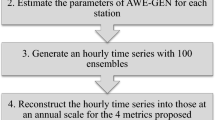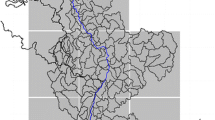Abstract
Climate internal variability (CIV) plays an important role in understanding climate and is one of the principal uncertainties in climate projections. This study aims to estimate CIV and climatological mean (CM) in predictions using different emission scenarios for South Korea. A stochastic weather generator is employed to generate 100 ensembles of 30-year hourly time series for 40 meteorological stations. CIV is then estimated from the detrended method and compared with the noise computed by the two approaches. The extremely high value of the coefficient of determination between CIV values and noise indicates that the methodologies are seamless. The key results of this study include: (1) national average CM and CIV will increase in the future, and that increase will be greater in Representative Concentration Pathway 8.5 and end periods; (2) the nature of future changes in CM and CIV differ according to the indices of interest. Characteristics of three precipitation-quantity indices (total precipitation, totPr; daily maximum precipitation, maxDa; and hourly maximum precipitation, maxHr) and the precipitation-occurrence index (the number of days without precipitation, nonPr) are largely distinct; (3) examining the relationship between factors of changes of CIV and CM reveal a high correlation between them for maxDa and maxHr, but not for other indices; (4) The tail information of distribution for the FOC ratio implies that future changes in total and extreme precipitation are likely to be decoupled for some months or at some locations. The degree of decoupling is more noticeable on the hourly than the daily scale; and (5) the spatial deviation of CIV is also larger during the summer when CIV values are spatially large; this is valid only for totPr and maxDa. Methodologies and results for finer scales help assess the impact of climate change and develop appropriate adaptation and response strategies.












Similar content being viewed by others
References
Aalbers EE, Lenderink G, van Meijgaard E, van den Hurk BJJM (2017) Local-scale changes in mean and heavy precipitation in Western Europe, climate change or internal variability? Clim Dyn 50(11–12):4745–4766
Addor N, Fischer EM (2015) The influence of natural variability and interpolation errors on bias characterization in RCM simulations. J Geophys Res Atmos 120(19):10180–110195
Barnes EA, Barnes RJ (2015) Estimating linear trends: simple linear regression versus epoch differences. J Clim 28(24):9969–9976
Bengtsson L, Hodges KI (2018) Can an ensemble climate simulation be used to separate climate change signals from internal unforced variability? Clim Dyn 52(5–6):3553–3573
Dai A, Bloecker CE (2018) Impacts of internal variability on temperature and precipitation trends in large ensemble simulations by two climate models. Clim Dyn 52(1–2):289–306
Deser C, Hurrell JW, Phillips AS (2016) The role of the North Atlantic Oscillation in European climate projections. Clim Dyn 49(9–10):3141–3157
Deser C, Phillips A, Bourdette V, Teng HY (2012a) Uncertainty in climate change projections: the role of internal variability. Clim Dyn 38(3–4):527–546
Deser C, Knutti R, Solomon S, Phillips AS (2012b) Communication of the role of natural variability in future North American climate. Nat Clim Change 2(11):775–779
Deser C, Phillips AS, Alexander MA, Smoliak BV (2014) Projecting North American climate over the next 50 years: uncertainty due to Internal Variability. J Clim 27(6):2271–2296
Domeisen DIV, Badin G, Koszalka IM (2018) How predictable are the arctic and North Atlantic Oscillations? Exploring the variability and predictability of the Northern Hemisphere. J Clim 31(3):997–1014
Fatichi S, Ivanov VY, Caporali E (2011) Simulation of future climate scenarios with a weather generator. Adv Water Resour 34(4):448–467
Fatichi S, Ivanov VY, Caporali E (2013) Assessment of a stochastic downscaling methodology in generating an ensemble of hourly future climate time series. Clim Dyn 40(7–8):1841–1861
Fischer EM, Knutti R (2014) Detection of spatially aggregated changes in temperature and precipitation extremes. Geophys Res Lett 41(2):547–554
Fischer EM, Beyerle U, Knutti R (2013) Robust spatially aggregated projections of climate extremes. Nat Clim Change 3(12):1033–1038
Fischer EM, Sedlacek J, Hawkins E, Knutti R (2014) Models agree on forced response pattern of precipiation and temperature extremes. Geophys Res Lett 41:8554–8562
Frankcombe LM, England MH, Mann ME, Steinman BA (2015) Separating internal variability from the externally forced climate response. J Clim 28(20):8184–8202
Giorgi F, Mearns LO (2002) Calculation of average, uncertainty range, and reliability of regional climate changes from AOGCM simulations via the "reliability ensemble averaging'' (REA) method. J Clim 15(10):1141–1158
Hawkins E, Sutton R (2009) The potential to narrow uncertainty in regional climate predictions. Bull Am Meteor Soc 90(8):1095–1108
Hawkins E, Sutton R (2010) The potential to narrow uncertainty in projections of regional precipitation change. Clim Dyn 37(1–2):407–418
Hawkins E, Smith RS, Gregory JM, Stainforth DA (2015) Irreducible uncertainty in near-term climate projections. Clim Dyn 46(11–12):3807–3819
Hingray B, Said M (2014) Partitioning internal variability and model uncertainty components in a multimember multimodel ensemble of climate projections. J Clim 27(17):6779–6798
Hu K, Huang G, Xie S-P (2018) Assessing the internal variability in multi-decadal trends of summer surface air temperature over East Asia with a large ensemble of GCM simulations. Clim Dyn 52:6229–6242
IPCC (2013) Climate change 2013: the physical science basis. In: Contribution of working group I to the fifth assessment report of the intergovernmental panel on climate change. Cambridge University Press, Cambridge
Ivanov VY, Bras RL, Curtis DC (2007) A weather generator for hydrological, ecological, and agricultural applications. Water Resour Res 43:W10406. https://doi.org/10.1029/2006WR005364
Kang I-S, Shukla J (2006) Dynamic seasonal prediction and predictability of the monsoon. In: Wang B (ed) The Asian monsoon. Springer, Berlin, pp 585–612
Kim J, Ivanov VY (2015) A holistic, multi-scale dynamic downscaling framework for climate impact assessments and challenges of addressing finer-scale watershed dynamics. J Hydrol 522:645–660
Kim J, Ivanov VY, Fatichi S (2016a) Soil erosion assessment—Mind the gap. Geophys Res Lett 43(24):12446–412456
Kim J, Ivanov VY, Fatichi S (2016b) Climate change and uncertainty assessment over a hydroclimatic transect of Michigan. Stoch Env Res Risk A 30(3):923–944
Kim J, Ivanov VY, Fatichi S (2016c) Environmental stochasticity controls soil erosion variability. Sci Rep 6(1):22065
Kim J, Tanveer ME, Bae DH (2018) Quantifying climate internal variability using an hourly ensemble generator over South Korea. Stoch Env Res Risk A 32(11):3037–3051
Kim J, Lee J, Kim D, Kang B (2019) The role of rainfall spatial variability in estimating areal reduction factors. J Hydrol 568:416–426
Lafaysse M, Hingray B, Mezghani A, Gailhard J, Terray L (2014) Internal variability and model uncertainty components in future hydrometeorological projections: the alpine durance basin. Water Resour Res 50(4):3317–3341
Martel J-L, Mailhot A, Brissette F, Caya D (2018) Role of natural climate variability in the detection of anthropogenic climate change signal for mean and extreme precipitation at local and regional scales. J Clim 31(11):4241–4263
Moise AF, Hudson DA (2008) Probabilistic predictions of climate change for Australia and southern Africa using the reliability ensemble average of IPCC CMIP3 model simulations. J Geophys Res Atmos 113:D15113. https://doi.org/10.1029/2007JD009250
Monerie P-A, Sanchez-Gomez E, Pohl B, Robson J, Dong B (2017) Impact of internal variability on projections of Sahel precipitation change. Environ Res Lett 12(11):114003
Olonscheck D, Notz D (2017) Consistently estimating internal climate variability from climate model simulations. J Clim 30(23):9555–9573
Peleg N, Molnar P, Burlando P, Fatichi S (2019) Exploring stochastic climate uncertainty in space and time using a gridded hourly weather generator. J Hydrol 571:627–641
Pendergrass AG, Knutti R, Lehner F, Deser C, Sanderson BM (2017) Precipitation variability increases in a warmer climate. Sci Rep 7(1):17966
Scaife AA, Smith D (2018) A signal-to-noise paradox in climate science. npj Clim Atmos Sci 1(1):1–8
Schindler A, Toreti A, Zampieri M, Scoccimarro E, Gualdi S, Fukutome S, Xoplaki E, Luterbacher J (2015) On the internal variability of simulated daily precipitation. J Clim 28(9):3624–3630
Simmons AJ, Hollingsworth A (2002) Some aspects of the improvement in skill of numerical weather prediction. Q J Roy Meteor Soc 128(580):647–677
Tebaldi C, Smith RL, Nychka D, Mearns LO (2005) Quantifying uncertainty in projections of regional climate change: a Bayesian approach to the analysis of multimodel ensembles. J Clim 18(10):1524–1540
Thompson DWJ, Barnes EA, Deser C, Foust WE, Phillips AS (2015) Quantifying the role of internal climate variability in future climate trends. J Clim 28(16):6443–6456
Tran VN, Kim J (2019) Quantification of predictive uncertainty with a metamodel: toward more efficient hydrologic simulations. Stoch Env Res Risk A 33(7):1453–1476
Von Storch H, Zwiers FW (2001) Statistical analysis in climate research. Cambridge University Press, Cambridge
Wang L, Deng A, Huang R (2018) Wintertime internal climate variability over Eurasia in the CESM large ensemble. Clim Dyn 52:6735–6748
Wilson EB, Hilferty MM (1931) The distribution of chi-square. Proc Natl Acad Sci U S A 17(12):684–688
Xie S-P et al (2015) Towards predictive understanding of regional climate change. Nat Clim Change 5(10):921–930
Zhang L, Wang C (2013) Multidecadal North Atlantic sea surface temperature and Atlantic meridional overturning circulation variability in CMIP5 historical simulations. J Geophys Res Oceans 118(10):5772–5791
Acknowledgements
This work was supported by the 2020 Research Fund of University of Ulsan.
Author information
Authors and Affiliations
Corresponding author
Additional information
Publisher's Note
Springer Nature remains neutral with regard to jurisdictional claims in published maps and institutional affiliations.
Electronic supplementary material
Below is the link to the electronic supplementary material.
Rights and permissions
About this article
Cite this article
Van Doi, M., Kim, J. Projections on climate internal variability and climatological mean at fine scales over South Korea. Stoch Environ Res Risk Assess 34, 1037–1058 (2020). https://doi.org/10.1007/s00477-020-01807-y
Published:
Issue Date:
DOI: https://doi.org/10.1007/s00477-020-01807-y




